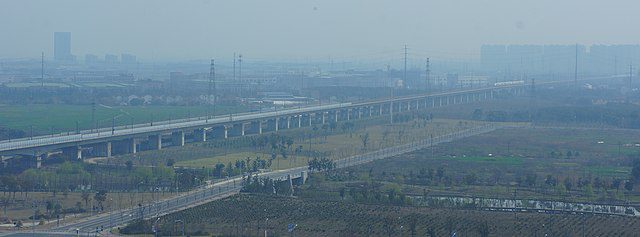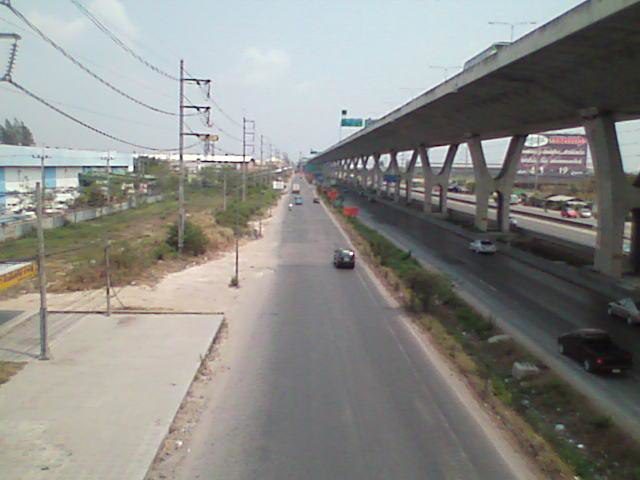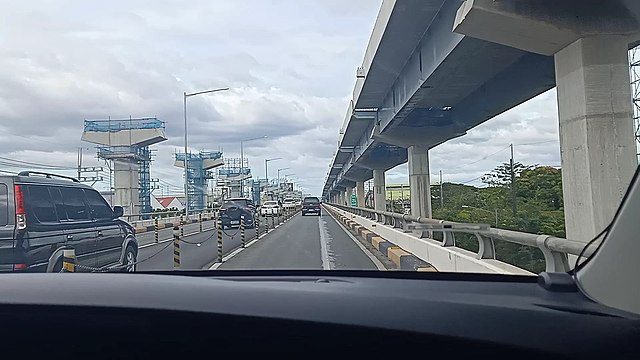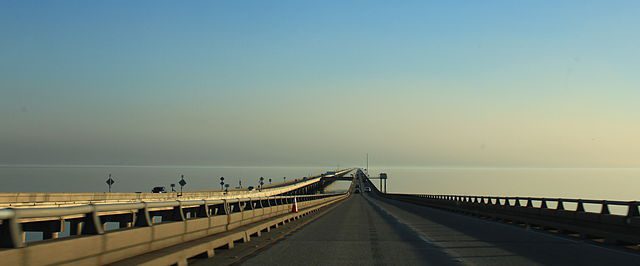20 Most Famous Bridges In The World
Bridges, architectural wonders that span rivers, seas, and oceans or serve as relief routes at intersections, represent a significant answer to the persistent problem of congestion in our modern highway systems. The concept of building bridges exemplifies a wonderful feat of human creativity and architectural expertise that has greatly enhanced modern society.
These magnificent structures serve a variety of functions. Bridges, for example, encourage global connection and facilitate efficient transportation networks by seamlessly connecting diverse places separated by enormous bodies of water or difficult terrains. They enable economic growth and regional development by removing physical barriers and boosting chances for interregional collaboration as conduits for commerce, trade, and cultural interaction.
Moreover, bridges epitomize the embodiment of human mobility, as they transcend the limitations of natural obstacles, forging a seamless path for individuals and goods to traverse otherwise impassable environments. By offering reliable and expedient transportation options, bridges enhance accessibility, reducing travel times and optimizing logistics. Consequently, they alleviate congestion on overburdened highways, mitigating the deleterious impact of traffic congestion on productivity, quality of life, and the environment.
Furthermore, bridges contribute to the preservation of natural resources by providing sustainable alternatives to conventional transportation routes. By diverting traffic from environmentally sensitive areas, such as ecologically fragile regions or protected wildlife habitats, bridges minimize ecological disruption and safeguard biodiversity. This environmentally conscious approach ensures the preservation of natural landscapes, enabling future generations to enjoy the beauty and ecological integrity of these invaluable ecosystems.
Bridges, in essence, have transformed the fabric of our civilization, acting as catalysts for connectivity, advancement, and long-term development. These magnificent monuments will live on as permanent emblems of human inventiveness and our unwavering resolve to transcend geographical borders. Bridges represent the substantial and long-lasting benefits they bestow on our modern world by providing increased mobility, reduced congestion, environmental protection, and economic development.
1.Danyang–Kunshan Grand Bridge – China

Danyang–Kunshan Grand Bridge jpg. MNXANL, CC BY-SA 4.0, via Wikimedia Commons
The Danyang–Kunshan Grand Bridge is a 164.8-kilometre-long viaduct on the Beijing–Shanghai High-Speed Railway. It is the longest bridge in the world. The bridge is located on the rail line between Shanghai and Nanjing in Jiangsu province. It is in the Yangtze River Delta, where the geography is characterized by lowland rice paddies, canals, rivers, and lakes.
The bridge runs roughly parallel to the Yangtze River, about 8 to 80 km south of the river. It passes through the northern edges of population centres beginning in Danyang, Changzhou, Wuxi, and Suzhou, and ending in Kunshan. There is a 9-kilometre-long section of open water across Yangcheng Lake in Suzhou.
Construction was completed in 2010 and the bridge opened in 2011. Employing 10,000 people, the project took four years and cost about $8.5 billion. The bridge currently holds the Guinness World Record for the longest bridge in the world in any category as of June 2011.
2. Changhua–Kaohsiung Viaduct (Taiwan)
The Changhua–Kaohsiung Viaduct is the world’s second-longest bridge. The bridge acts as a viaduct for part of the railway line of the Taiwan High-Speed Rail network. Over 200 million passengers had been carried over it by December 2012. The viaduct starts in Baguashan in Changhua County and ends in Zuoying in Kaohsiung.
The bridge, finished in 2004, spans a distance of 157.317 kilometres. It incorporates a network of viaducts to ensure its resilience against earthquakes, allowing trains to stop safely during seismic events and sustain repairable damage in the event of a maximum-design earthquake. Bridges constructed over recognized fault lines were engineered to withstand fault movements without experiencing catastrophic destruction.
3. Bang Na Expressway, Thailand

Bangna-Bangpakong Road.jpgMiniwildebeest at English Wikipedia(Original text: Miniwildebeest (talk)), Public domain, via Wikimedia Commons
The Bang Na Expressway is a 55-kilometre-long six-lane elevated highway in Thailand. It is a toll road and runs above National Highway Route 34, (Bang Na–Trat Highway) owned by the Expressway Authority of Thailand (EXAT). The bridge was the achievement of Sukavich Rangsitpol deputy prime minister of Chuan Leekpai Cabinet (1992-1995).
The Bang Na Expressway was designed by the late Louis Berger. From 2000 to 2008, the Bang Na Expressway, recognized as the world’s longest car bridge, held the distinction of being the longest bridge globally. Presently, it ranks as the seventh longest bridge worldwide.
4. Metro Manila Skyway, Phillippines

Skyway Manila Stage 2 (Alabang Section) 2021-01-02.jpgLMP 2001, CC BY-SA 4.0, via Wikimedia Commons
The Metro Manila Skyway, also known as the Metro Manila Skyway System (MMSS) or simply the Skyway, is an elevated highway that serves as the primary expressway in Metro Manila, Philippines. It connects the North and South Luzon Expressways (NLEX and SLEX) and provides access to Ninoy Aquino International Airport through the NAIA Expressway (NAIAX). With a length of approximately 39.2 kilometres, it is one of the longest elevated highways globally and the first fully grade-separated highway in the country.
Spanning over major existing highways and the San Juan River, the Skyway traverses densely urbanized areas including Caloocan, Quezon City, Manila, Makati, Pasay, Taguig, Parañaque, and Muntinlupa. Its presence has alleviated congestion on other significant roadways in the region. The Skyway accommodates Class 1 vehicles, such as cars, vans, motorcycles with an engine displacement above 400 cc (24 cu in), pick-up trucks, and SUVs. Class 2 vehicles and public utility vehicles (PUVs) were previously prohibited due to the ongoing construction of the extension project.
5. Lake Pontchartrain Causeway, USA

Lake Pontchartrain Causeway 2011.jpgNavin Rajagopalan, CC BY-SA 2.0, via Wikimedia Commons
The Lake Pontchartrain Causeway also referred to as The Causeway, is a pair of parallel bridges that connect southeastern Louisiana, United States, by crossing Lake Pontchartrain. The longer of the two bridges measures 23.83 miles (38.35 km) in length. The southern starting point of the causeway is located in Metairie, a suburb on the south shore of New Orleans, while the northern end is in Mandeville, a suburb on the north shore of New Orleans.
For several decades, from 1969 to 2011, the Lake Pontchartrain Causeway held the Guinness World Record as the longest bridge over water globally. However, in 2011, the creation of separate categories for bridge lengths over water led to the Causeway being recognized as the longest bridge over water in terms of continuous length, while the Jiaozhou Bay Bridge in China claimed the record for the longest bridge over water in terms of aggregate length.
The construction of the bridges involved the use of 9,500 concrete pilings. Additionally, a bascule section is incorporated into the design of the bridges to span the navigation channel, located approximately 8 miles (13 km) south of the north shore.
6. Sheikh Mohammed bin Zayed Skyway, Indonesia

Sheikh Mohammed bin Zayed Skyway jpg. @preplime, CC BY-SA 4.0, via Wikimedia Commons
The Sheikh Mohammed bin Zayed Skyway, also known as the MBZ Skyway, previously referred to as the Jakarta-Cikampek Elevated Toll Road, is an elevated expressway in West Java, Indonesia. Stretching for a length of 36.4 kilometres, it runs from Cikunir, Bekasi, to Karawang. The operation of the toll road is managed by PT Jasamarga Jalanlayang Cikampek, a subsidiary of PT Jasa Marga Tbk and PT Nusantara Infrastructure Tbk, with PT Ranggi Sugiron Perkasa as a minority shareholder.
The MBZ Skyway is constructed above certain sections of the existing Jakarta-Cikampek Toll Road. It holds the distinction of being the longest flyover in Indonesia and the lengthiest elevated double-decker expressway in Southeast Asia. The toll road was officially inaugurated by President Joko Widodo on December 11, 2019, and was subsequently renamed the Sheikh Mohammed bin Zayed Skyway on April 8, 2021, at the request of the President’s secretary.
7. Sheikh Jaber Al-Ahmad Al-Sabah Causeway, Kuwait
The Sheikh Jaber Al-Ahmad Al-Sabah Causeway is a significant infrastructure project in Kuwait, with a construction value estimated at around US$3 billion. It is a part of the Silk City project under China’s Belt and Road Initiative, constituting the first phase. The causeway spans the Bay of Kuwait in two directions, comprising the Main Link and the Doha Link. The Main Link connects Kuwait City with northern Kuwait, including Subiya and Bubiyan Island, while the Doha Link connects Kuwait City with Doha.
Two artificial islands, Bay Island North and Bay Island South, were specifically constructed for entertainment and tourism purposes as part of this project. The causeway is a key component of Kuwait Vision 2035 and is named after the late Sheikh Jaber Al-Sabah in recognition of his contributions to Kuwait’s development.
It stands as one of the largest and most challenging transportation infrastructure ventures in Kuwait and the wider Middle East region. The Main Link holds the distinction of being the fourth longest road bridge globally, spanning a length of 36.14 kilometres. Overall, the causeway consists of two bridges, combining for a total length of 48.5 kilometres.
8. Sultan Haji Omar Ali Saifuddien Bridge, Brunei Darussalam

Sultan Haji Omar Ali Saifuddien Bridge 01.jpgPangalau, CC BY-SA 4.0, via Wikimedia Commons
Sultan Haji Omar ‘Ali Saifuddien Bridge also known as Temburong Bridge (Malay: Jambatan Temburong, is a dual-carriageway bridge in Brunei that spans across Brunei Bay, connecting the Bruneian mainland with its semi-exclave of Temburong. It is the longest bridge in Southeast Asia, 30 kilometres long.
Construction on the bridge commenced in 2014 with an original target completion date of late 2019. However, due to the impact of the COVID-19 pandemic, the bridge was opened earlier than planned on March 17, 2020. The accelerated opening was prompted by Brunei’s implementation of travel restrictions, which would have otherwise isolated Temburong from the rest of the country.
The bridge was officially named the Sultan Haji Omar ‘Ali Saifuddien Bridge on July 14, 2020, in honour of Sultan Haji Omar ‘Ali Saifuddien Saadul Khairi Waddien, the late father of Sultan Haji Hassanal Bolkiah, who is credited with shaping modern Brunei.
9. Blue Line, India

Blue Line.jpgKool Nerd 123, CC BY-SA 4.0, via Wikimedia Commons
The Blue Line, comprised of Line 3 and Line 4, is a metro rail line within the Delhi Metro network in Delhi, India. It holds the distinction of being the longest line in terms of total length. The Main Line (Line 3) stretches from Noida Electronic City to Dwarka Sector 21, covering a distance of 56.11 kilometres with 50 stations. Additionally, there is a Branch Line (Line 4) with 8 stations running from Vaishali to Yamuna Bank, spanning a length of 8.51 kilometres.
Previously, the Main Line (Line 3) held the record as the longest line within the Delhi Metro network. However, on August 6, 2021, an unfinished section between Mayur Vihar Pocket 1 and Trilokpuri Sanjay Lake stations on the Pink Line was inaugurated, resulting in the creation of a 59-kilometre-long corridor.
Read OnThe Magnificent Taj Mahal: 10 Things To Know About its Architecture
10. Sultan Abdul Halim Muadzam Shah Bridge, Malasyia

Second Penang Bridge at Batu Maung, Penang.jpgVnonymous, CC BY-SA 4.0, via Wikimedia Commons
The Sultan Abdul Halim Muadzam Shah Bridge, also known as the Penang Second Bridge, is a toll bridge located in Penang, Malaysia. It connects Bandar Cassia in Seberang Perai on the mainland with Batu Maung on Penang Island. The bridge was constructed by China Harbour Engineering Co Ltd (CHEC) and is the second bridge to link the island with the mainland, following the first Penang Bridge.
The Sultan Abdul Halim Muadzam Shah Bridge spans a total length of 24 km (15 mi), with 16.9 km (10.5 mi) of that length over water. This makes it the longest bridge in Malaysia and the second longest in Southeast Asia. The construction of the bridge began in November 2008, and it was originally assigned the route code E22. However, the route code was later changed to E28 to avoid conflicts with the Senai–Desaru Expressway.
Due to cost considerations, the bridge’s design was modified to resemble the first cable-stayed Penang Bridge. The construction of the bridge was financially supported by a substantial loan from the People’s Republic of China, which aimed to strengthen the economic relationship between China and Malaysia. The bridge was officially opened on 1 March 2014, at 20:30 MST, and was named after the late Tuanku Abdul Halim Muadzam Shah of Kedah, who served as the fourteenth Yang di-Pertuan Agong (the head of state) of Malaysia. It was also assigned the route number E28.
11. Incheon Bridge, South Korea
The Incheon Bridge is a cable-stayed bridge made of reinforced concrete situated in South Korea. It was opened in October 2009 and serves as the second bridge connecting Yeongjong Island to the mainland of Incheon. Notably, it is the longest cable-stayed bridge in South Korea and ranks as the world’s tenth-longest cable-stayed bridge as of January 2019.
One of the significant advantages of the Incheon Bridge is that it provides a direct route between Songdo and Incheon International Airport, reducing travel time by up to one hour.
The sea-crossing portion of the bridge, managed by the Incheon Bridge Corporation, is privately funded. The project is overseen by the Korea Expressway Corporation and the Korean Ministry of Land, Transport, and Maritime Affairs (MLTM). The Incheon Bridge is positioned south of the Yeongjong Bridge, which was the initial bridge connecting Yeongjong Island to the mainland.
12.6th October Bridge, Egypt
The 6th October Bridge, known as Kubri 6 uktubar in Arabic, is a raised highway located in the central area of Cairo, Egypt. This 20.5-kilometre bridge and causeway cross the Nile River twice, connecting the western bank suburbs to Downtown Cairo and extending further to link the city with the Cairo International Airport in the east.
The bridge is named in remembrance of the significant event called ‘The Crossing,’ which marked the beginning of the Yom Kippur War in 1973. The building of the 6th October Bridge and Causeway has been declared a national infrastructure project. In April 2021, President Abdel Fattah el-Sisi gave the order to expand and upgrade the bridge, as well as the roads underneath it.
13. Crimean Bridge, Russia & Ukraine

Крымский мост 21 декабря 2019 года.jpgRosavtodor.ru, CC BY 4.0, via Wikimedia Commons
The Crimean Bridge, also known as the Kerch Strait Bridge or Kerch Bridge, consists of two parallel bridges—one for a four-lane road and one for a double-track railway. These bridges span the Kerch Strait, connecting the Taman Peninsula of Krasnodar Krai in Russia with the Kerch Peninsula of Crimea, Ukraine. The Russian Federation constructed the bridge after the controversial annexation of Crimea in 2014. It cost ₽227.92 billion (US$3.7 billion) and has a length of 19 km. This makes it the longest bridge in Europe and the longest bridge ever built by Russia.
14. Vasco da Gama Bridge, Portugal

Vasco da Gama Bridge B&W (crop2).jpg William Warbyderivative work: Bruce1ee, CC BY 2.0, via Wikimedia Commons
The Vasco da Gama Bridge, known as Ponte Vasco da Gama in Portuguese, is a cable-stayed bridge with viaducts on both sides, crossing the Tagus River in Parque das Nações, Lisbon, the capital of Portugal. It holds the distinction of being the second longest bridge in Europe, following the Crimean Bridge, and is the longest bridge within the European Union. The primary purpose of constructing this bridge was to alleviate traffic congestion on Lisbon’s 25 de Abril Bridge and provide an alternative route for north-south traffic, avoiding the need to pass through the capital city.
Construction of the Vasco da Gama Bridge commenced in February 1995, and it was opened to traffic on 29 March 1998, just in time for Expo 98, a World’s Fair that celebrated the 500th anniversary of Vasco da Gama’s discovery of the sea route from Europe to India. The Vasco da Gama Bridge and the 25 de Abril Bridge are the two bridges that span the Tagus River in Lisbon.
15. Pont de Wandre, Belgium

Pont de Wandre le 04.02.2006 (6).jpgBeideler RenéBeideler René at fr.wikipedia, CC BY-SA 3.0, via Wikimedia Commons
The Pont de Wandre is a single-pier cable-stayed bridge carrying the N667 road across the Albert Canal and the river Meuse between Liège (on the east side) and Herstal (on the west side), both in Belgium. The bridge, including its approach sections, has a total length of approximately 527 meters. The main cable-stayed spans of the bridge measure 144 meters and 168 meters respectively. The primary support structure of the bridge is constructed in an inverted Y shape using concrete and stands at a height of 88.5 meters. This support structure carries a road deck that is 22 meters wide.
During the period from the 15th to the 19th century, people relied on a ferry to cross the Meuse River at Wandre. However, in 1884, the first bridge was constructed to connect Herstal and Wandre. This bridge comprised a metal bowstring bridge over the canal, a seven-arched viaduct made of brick and stone spanning the land between the two waterways, and finally, a rectangular girder truss bridge over the Meuse, supported by three piers.
16. Abdoun Bridge, Jordan

WadiAbdoun1.jpgThe original uploader was Ldud at English Wikipedia., Public domain, via Wikimedia Commons
The Wadi Abdoun Bridge, also known as the Kamal Al-Shair Bridge, is located in Amman, Jordan. It is the country’s only cable-stayed bridge and spans over the Wadi Abdoun. Construction of the bridge began on December 14, 2002, and it was officially opened on December 14, 2006. The bridge was constructed by Larsen & Toubro Limited, an Indian multinational company. It is an integral part of Amman’s Beltway project and serves as a link between South Amman, the 4th Circle, and Zahran Street.
17. Khaju Bridge, Iran

Khaju bridge 1.jpgJ.salehifar, CC BY-SA 4.0, via Wikimedia Commons
The Khaju Bridge, also known as Pol-e Xāju in Persian, is a historic bridge located in Isfahan, Iran. It spans the Zayanderud River, the largest river in the Iranian Plateau. The Khaju Bridge serves a dual purpose as both a bridge and a weir, connecting the Khaju quarter on the north bank to the Zoroastrian quarter on the other side of the Zayanderud. It is situated at the end of Kamal Ismail Street in Isfahan.
In the past, the Khaju Bridge played a crucial role as a gathering place for public meetings and also served as a prominent architectural structure in the city. It is often regarded as the finest bridge in Isfahan.
Notably, nearby the bridge, there is a mausoleum where Persian art historians and revivalists Arthur Upham Pope and Phyllis Ackerman have been laid to rest.
18. Vashi Bridge, Israel

Vashi creek flyover 2020.jpgKarthikndr, CC BY-SA 4.0, via Wikimedia Commons
The Vashi Bridge, also referred to as the Thane Creek Bridge or the Second Thane Creek Bridge, is a road bridge that was constructed in the late 1990s. It spans Thane Creek, providing a connection between the city of Mumbai and the Indian mainland at Navi Mumbai. The bridge serves as a link between the suburb of Mankhurd in Mumbai and Vashi in Navi Mumbai, which is a satellite city of Mumbai.
It is one of the four entry points into Mumbai, with the other three being the Airoli Bridge upstream across Thane Creek, Mulund, and Dahisar. The Vashi Bridge primarily handles traffic heading towards the southern and eastern regions of Mumbai.
This bridge replaces the older Thane Creek or Vashi Bridge, which was constructed in 1973 and is still standing to the north of the current bridge. However, the older bridge is no longer open to traffic due to construction defects. As of 2020, plans are in place to construct a third Thane Creek/Vashi Bridge.
19. Adomi Bridge, Ghana

Lake Volta 07.jpgNora Morgan, CC BY 2.0, via Wikimedia Commons
The Adomi Bridge, originally known as the Volta Bridge, is an arched suspension bridge made of latticed steel. It crosses the Volta River at Atimpoku in Ghana, situated in West Africa. This bridge holds significance as it is the first permanent structure built to span the Volta River, which flows south into the Gulf of Guinea. It is also recognized as Ghana’s longest suspension bridge.
The Adomi Bridge serves as a vital road link, located just south of the Akosombo Dam, connecting the Eastern Region and the Volta Region of Ghana. In 1957, it was inaugurated by Kwame Nkrumah, the first president of Ghana. The distinctive and recognizable design of the bridge, featuring a crescent-shaped arch, has made it an iconic symbol depicted on Ghanaian stamps and currency.
20. Loschwitz Bridge, Germany

Blaues Wunder.jpgNikater, CC BY-SA 3.0, via Wikimedia Commons
The Loschwitz Bridge, also known as the Blaues Wunder (“Blue Wonder”), is a cantilever truss bridge situated over the Elbe River in Dresden, the capital of Saxony, Germany. It serves as a vital link between the affluent residential areas of Blasewitz and Loschwitz, which were once considered among the most expensive in Europe around 1900. The bridge is conveniently located near the Standseilbahn Dresden funicular railway, the Schwebebahn Dresden (the world’s oldest suspension railway), and the Dresden TV tower.
The colloquial name “Blue Wonder” stems from the bridge’s original blue colour and its reputation as a technological marvel during its time. Interestingly, the name carries a touch of cynicism, as it is also associated with the German idiom “ein blaues Wunder erleben,” meaning “to experience an unpleasant surprise.” This reflects the sceptical perspective of contemporary observers, adding a subtle layer of irony to the bridge’s moniker.
Planning a trip to Paris ? Get ready !
These are Amazon’s best-selling travel products that you may need for coming to Paris.
Bookstore
- The best travel book : Rick Steves – Paris 2023 – Learn more here
- Fodor’s Paris 2024 – Learn more here
Travel Gear
- Venture Pal Lightweight Backpack – Learn more here
- Samsonite Winfield 2 28″ Luggage – Learn more here
- Swig Savvy’s Stainless Steel Insulated Water Bottle – Learn more here
Check Amazon’s best-seller list for the most popular travel accessories. We sometimes read this list just to find out what new travel products people are buying.










